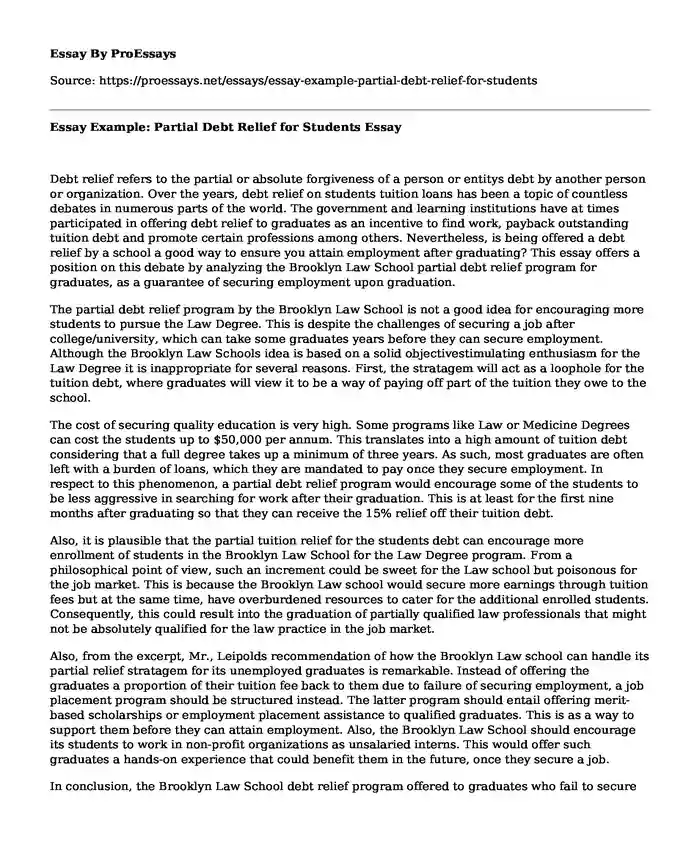Debt relief refers to the partial or absolute forgiveness of a person or entitys debt by another person or organization. Over the years, debt relief on students tuition loans has been a topic of countless debates in numerous parts of the world. The government and learning institutions have at times participated in offering debt relief to graduates as an incentive to find work, payback outstanding tuition debt and promote certain professions among others. Nevertheless, is being offered a debt relief by a school a good way to ensure you attain employment after graduating? This essay offers a position on this debate by analyzing the Brooklyn Law School partial debt relief program for graduates, as a guarantee of securing employment upon graduation.
The partial debt relief program by the Brooklyn Law School is not a good idea for encouraging more students to pursue the Law Degree. This is despite the challenges of securing a job after college/university, which can take some graduates years before they can secure employment. Although the Brooklyn Law Schools idea is based on a solid objectivestimulating enthusiasm for the Law Degree it is inappropriate for several reasons. First, the stratagem will act as a loophole for the tuition debt, where graduates will view it to be a way of paying off part of the tuition they owe to the school.
The cost of securing quality education is very high. Some programs like Law or Medicine Degrees can cost the students up to $50,000 per annum. This translates into a high amount of tuition debt considering that a full degree takes up a minimum of three years. As such, most graduates are often left with a burden of loans, which they are mandated to pay once they secure employment. In respect to this phenomenon, a partial debt relief program would encourage some of the students to be less aggressive in searching for work after their graduation. This is at least for the first nine months after graduating so that they can receive the 15% relief off their tuition debt.
Also, it is plausible that the partial tuition relief for the students debt can encourage more enrollment of students in the Brooklyn Law School for the Law Degree program. From a philosophical point of view, such an increment could be sweet for the Law school but poisonous for the job market. This is because the Brooklyn Law school would secure more earnings through tuition fees but at the same time, have overburdened resources to cater for the additional enrolled students. Consequently, this could result into the graduation of partially qualified law professionals that might not be absolutely qualified for the law practice in the job market.
Also, from the excerpt, Mr., Leipolds recommendation of how the Brooklyn Law school can handle its partial relief stratagem for its unemployed graduates is remarkable. Instead of offering the graduates a proportion of their tuition fee back to them due to failure of securing employment, a job placement program should be structured instead. The latter program should entail offering merit-based scholarships or employment placement assistance to qualified graduates. This is as a way to support them before they can attain employment. Also, the Brooklyn Law School should encourage its students to work in non-profit organizations as unsalaried interns. This would offer such graduates a hands-on experience that could benefit them in the future, once they secure a job.
In conclusion, the Brooklyn Law School debt relief program offered to graduates who fail to secure employment within the first nine months of graduation should not be considered an effective strategy. This is because it will encourage some students to take advantage of the incentive as a way of paying back some of the tuition debt they owe to the learning institution. Instead, the Brooklyn Law School should adopt other strategies of encouraging the graduates to attain employment such as helping them with job placement. The school should also encourage the affected graduates to work for non-profit organizations as unsalaried interns, where they can gain hands-on experience for their future career opportunities.
Cite this page
Essay Example: Partial Debt Relief for Students. (2021, Apr 19). Retrieved from https://proessays.net/essays/essay-example-partial-debt-relief-for-students
If you are the original author of this essay and no longer wish to have it published on the ProEssays website, please click below to request its removal:
- Essay Example on Student Loans: Necessity or Misuse?
- Critical Thinking about College Graduates
- Essay Sample on Western Canon: Controversy Over Canonical Influence on Scholars
- Essay Example on Valuing Bonds: Essential Components & Call Provisions
- Paper Example on Nostalgic Fishing Vacation on a Sunny Day
- Essay Example on Fraud in Accounting: Rebuttal of Financial Statement Manipulation
- Impact of Merger & Acquisition Announcements on Stocks Market Behavior In the UK







